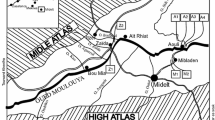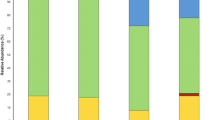Abstract
The excessive concentrations of toxic heavy metals in mine tailings and their very low N content make soil reclamation strategies by phytostabilization difficult. Our objective was to test if the symbiotic association between the legume Anthyllis vulneraria subsp. carpatica and the bacteria Mesorhizobium metallidurans originating from highly polluted mine tailings is able to increase N concentration in soils with contrasting Zn, Pb and Cd contents. Plants of A. vulneraria subsp. carpatica from a mine site and of a non-metallicolous subsp. praeopera from non-polluted soil were inoculated with a metallicolous or a non-metallicolous compatible Mesorhizobium spp. and grown on low and high heavy metal-contaminated soils. In contaminated soil, many nodules were observed when the metallicolous A. vulneraria was inoculated with its rhizobium species M. metallidurans, whereas the non-metallicolous A. vulneraria died after a few weeks regardless of the rhizobium inoculant. Eighty percent of the total nitrogen was derived from biological nitrogen fixation through the association between metallicolous A. vulneraria and the rhizobium grown on metal-enriched soil. The ability of the metallicolous A. vulneraria to develop a high nitrogen fixing potential opens new possibilities for promoting a low-maintenance plant cover and for stabilizing the vegetation in high heavy metal-contaminated soils.

Similar content being viewed by others
References
Baker AJM, Walker PL (1990) Ecophysiology of metal uptake by tolerance plants. In: Shaw AJ (ed) Heavy metal tolerance plants: evolutionary aspects. CRC, Boca Raton, pp 155–177
Bertrand H, Plassard C, Pinochet X, Touraine B, Normand P, Cleyet-Marel JC (2000) Stimulation of the ionic-transport system in Brassica napus by a plant growth-promoting rhizobacterium (Achromobacter sp.). Can J Microbiol 46:229–236
Boularbah A, Schwartz C, Bitton G, Aboudrar W, Ouhammou A, Morel JL (2006) Heavy metal contamination from mining sites in South Morocco: 2. Assessment of metal accumulation and toxicity in plants. Chemosphere 63:811–817
Broos K, Uyttebroek M, Mertens J, Smolders E (2004) A survey of symbiotic nitrogen fixation by white clover grown on metal contaminated soils. Soil Biol Biochem 36:633–640
Broos K, Beyens H, Smolders E (2005) Survival of rhizobia in soils is sensitive to elevated zinc in the absence pf the host plant. Soil Biol Biochem 37:573–579
Carrasco JA, Armario P, Pajuelo E, Burgos A, Caviedes MA, Lopez R, Chamber MA, Palomares AJ (2005) Isolation and characterisation of symbiotically effective Rhizobium resistant to arsenic and heavy metals after the toxic spill at the Aznalcollar pyrite mine. Soil Biol Biochem 37:1131–1140
Castro IV, Ferreira EM, McGrath SP (1997) Effectiveness and genetic diversity of Rhizobium leguminosarum bv. trifolii isolates in Portuguese soils polluted by industrial effluents. Soil Biol Biochem 29:1209–1213
Chaudhary P, Dudeja SS, Kapoor KK (2004) Effectivity of host-Rhizobium leguminosarum symbiosis in soils receiving sewage water containing heavy metals. Microbiol Res 159:121–127
Chaudri AM, McGrath SP, Giller KE, Rietz E, Sauerbeck DR (1993) Enumeration of indigenous Rhizobium leguminosarum biovar trifolii in soils previously treated with metal-contaminated sewage sludge. Soil Biol Biochem 25:301–309
Chaudri A, McGrath S, Gibbs P, Chambers B, Carlton-Smith C, Bacon J, Campbell C, Aitken M (2008) Population size of indigenous Rhizobium leguminosarum biovar trifolii in long-term field experiments with sewage sludge cake, metal-amended liquid sludge or metal salts: effects of zinc, copper and cadmium. Soil Biol Biochem 40:1670–1680
Cottenie A, Verloo M, Kiekens L, Velghe G, Camerlynk R (1982) Chemical analysis of plants and soils. State University Ghent, Laboratory of analytical and agrochemistry
Crozat Y, Cleyet-Marel JC (1984) Problèmes méthodologiques posés par l’extraction et la récupération des bactéries telluriques pour leur quantification par immunofluorescence. Agronomie 4:603–610
Delves AC, Mathews A, Day DA, Carter AS, Carroll BJ, Gresshoff PM (1986) Regulation of the soybean-Rhizobium nodule symbiosis by shoot and root factors. Plant Physiol 82:588–590
El-Kenawy ZA, Angle JS, Gewaily EM, El-Wafai NA, van Berkum P, Chaney RL, Ibekwe MA (1997) Zinc and cadmium effects on the early stages of nodulation in white clover. Agron J 89:875–880
Ernst WHO (1990) Mine vegetation in Europe. In: Shaw AJ (ed) Heavy metal tolerance in plants: evolutionary aspects. CRC, Boca Raton, pp 21–37
Ernst WHO (1996) Bioavailability of heavy metals and decontamination of soils by plants. Appl Geochem 11:163–167
Escarré J, Lefèbvre C, Gruber W, Leblanc M, Lepart J, Rivière Y, Delay B (2000) Zinc and cadmium hyperaccumulation by Thlaspi caerulescens from metalliferous and non-metalliferous sites in the Mediterranean area: implications for phytoremediation. New Phytol 145:429–437
Escarré J, Lefèbvre C, Raboyeau S, Dossantos A, Gruber W, Cleyet-Marel JC, Frérot H, Noret N, Mahieu S, Collin C, Van Oort F (2010) Heavy metal concentration survey in soils and plants of the Les Malines mining district (Southern France): implications for soil restoration. Water Air Soil Pollut (in press).
Frérot H, Lefèbvre C, Gruber W, Collin C, Dos Santos A, Escarré J (2006) Specific interactions between local metallicous plants improve the phytostabilisation of mine soils. Plant Soil 282:53–65
Giller KE, Witter E, McGrath SP (2009) Heavy metals and soil microbes. Soil Biol Biochem 41:2031–2037
Harper JL (1977) The population biology of plants. Academic, London
Harris JA, Birch P, Palmer JP (1996) Land restoration and reclamation: principles and practice. Longman, England
Khan M, Zaidi A, Wani P, Oves M (2009) Role of plant growth promoting rhizobacteria in the remediation of metal contaminated soils. Environ Chem Lett 7:1–19
Kosslak RM, Ben Bohlool BB (1984) Suppression of nodule development of one side of a split-root system of soybeans caused by prior inoculation of the other side. Plant Physiol 75:125–130
Krussell L, Madsen LH, Sato S, Aubert G, Genua A, Szczyglowski K, Duc G, Kaneko T, Tabata S, de Bruijn F, Pajuelo E, Sandal N, Stougaard J (2002) Shoot control of root development and nodulation is mediated by a receptor-like kinase. Nature 420:422–426
Lakzian A, Murphy P, Turner A, Beynon JL, Giller KE (2002) Rhizobium leguminosarum bv. viciae populations in soils with increasing heavy metal contamination: abundance, plasmid profiles, diversity and metal tolerance. Soil Biol Biochem 34:519–529
Loh J, Stacey G (2003) Nodulation gene regulation in Bradyrhizobium japonicum: a unique integration of global regulatory circuits. Appl Environ Microbiol 69:10–17
Mathys W (1977) The role of malate, oxalate and mustard oil glucosides in the evolution of zinc-resistance in herbage plants. Physiol Plant 40:130–136
McGrath SP, Brooks PC, Giller KE (1988) Effects of potentially toxic metals in soil derived from past applications of sewage sludge on nitrogen fixation by Trifolium repens L. Soil Biol Biochem 20:415–424
Mergeay M, Monchy S, Vallaeys T, Auquier V, Benotmane A, Bertin P, Taghavi S, Dunn J, Van der Lelie D, Wattiez R (2003) Ralstonia metalllidurans, a bacterium specifically adapted to toxic metals: towards a catalogue of metal-responsive genes. FEMS Microbiol Rev 27:385–410
Obbard JP, Jones KC (2001) Measurements of symbiotic nitrogen-fixation in leguminous host-plants grown in heavy metal-contaminated soils amended with sewage sludge. Environ Pollut 111:311–320
Parker MA (1995) Plant fitness variation caused by different mutualist genotypes. Ecology 76:1525–1535
Rastetter EB, Vitousek PM, Field C, Shaver GR, Herbert D, Agren GI (2001) Resource optimization and symbiotic nitrogen fixation. Ecosystems 4:369–388
Rother JA, Millbank JW, Thornton I (1982) Seasonal fluctuations in nitrogen fixation (acetylene reduction) by free-living bacteria in soils contaminated with cadmium, lead and zinc. Eur J Soil Sci 33:101–113
Salt DE, Smith RD, Raskin I (1998) Phytoremediation. Ann Rev Plant Physiol Plant Mol Biol 49:643–668
Sans FX, Escarré J, Gorse V, Lepart J (1998) Persistence of Picris hieracioides populations in old fields: an example of facilitation. Oikos 83:283–292
SAS (1985) SAS user’s guide: statistics, 5, 5th edn. SAS, Cary
Schat H, Ten Bookum WM (1992) Genetic control of copper tolerance in Silene vulgaris. Heredity 68:219–229
Underwood AJ (1981) Techniques of analysis of variance in experimental marine biology and ecology. Oceanogr Mar Biol 19:513–605
Van der Heijden MGA, Bakker R, Verwaal J, Scheublin TR, Rutten M, van Logtestijn R, Staehelin C (2006) Symbiotic bacteria as a determinant of plant community structure and plant productivity in dune grassland. FEMS Microbiol Ecol 56:178–187
Vaneechoutte M, Kämpfer P, De Baere T, Falsen E, Verschraegen G (2004) Wautersia gen. nov., a novel genus accommodating the phylogenetic lineage including Ralstonia eutropoha and related species, and proposal of Ralstonia (Pseudomonas) syzygii (Roberts et al. 1990) comb. Nov Int J Syst Evol Microbiol 54:317–327
Vidal C, Chantreuil C, Berge O, Mauré L, Escarré J, Béna G, Brunel B, Cleyet-Marel JC (2009) Mesorhizobium metallidurans sp. nov., a novel metal resistant symbiont of Anthyllis vulneria growing on metallicolous soil in Languedoc, France. Int J Syst Evol Microbiol 59:850–855
Vitousek PM, Field CB (1999) Ecosystem constraints to symbiotic nitrogen fixers: a simple model and its implications. Biogeochem 46:179–202
Whiting SN, Reeves RD, Richard D, Johnson MS, Cooke JA, Malaisse F, Paton A, Smith JAC, Angle JS, Chaney RL, Ginocchio R, Jaffré T, Johns R, McIntyre T, Purvis OW, Salt DE, Zhao FJ, Baker AJM (2004) Research priorities for conservation of metallophytes biodiversity and their potential for restoration and site remediation. Restor Ecol 12:106–116
Acknowledgements
The authors thank Guy Delmot for authorizing the work at the Les Avinières site and for his kind hospitality. The research was supported by the grant EMETER of the Agence de l’Environnement et de la Maîtrise de l’Energie (ADEME contract 04.72.C.0037). The Ph. D. of C. Vidal was financed by ADEME and the Région Languedoc-Roussillon.
Author information
Authors and Affiliations
Corresponding author
Additional information
Responsible Editor: Henk Schat.
Rights and permissions
About this article
Cite this article
Mahieu, S., Frérot, H., Vidal, C. et al. Anthyllis vulneraria/Mesorhizobium metallidurans, an efficient symbiotic nitrogen fixing association able to grow in mine tailings highly contaminated by Zn, Pb and Cd. Plant Soil 342, 405–417 (2011). https://doi.org/10.1007/s11104-010-0705-7
Received:
Accepted:
Published:
Issue Date:
DOI: https://doi.org/10.1007/s11104-010-0705-7




